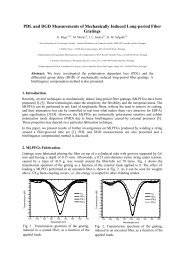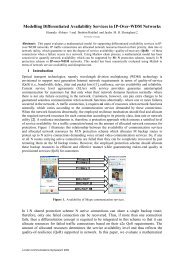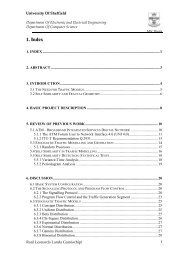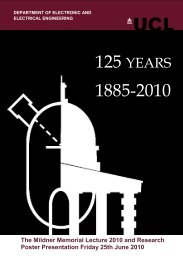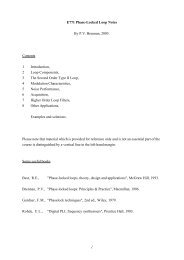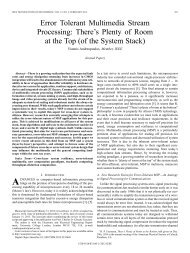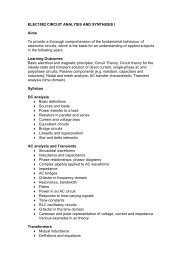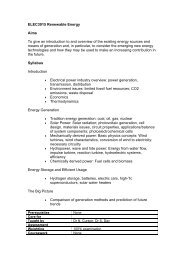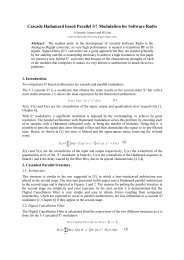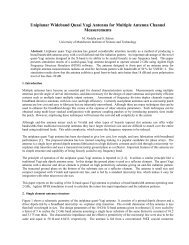Investigation of Cross-Phase Modulation in WDM Systems with AM ...
Investigation of Cross-Phase Modulation in WDM Systems with AM ...
Investigation of Cross-Phase Modulation in WDM Systems with AM ...
Create successful ePaper yourself
Turn your PDF publications into a flip-book with our unique Google optimized e-Paper software.
<strong>Investigation</strong> <strong>of</strong> <strong>Cross</strong>-<strong>Phase</strong> <strong>Modulation</strong> <strong>in</strong> <strong>WDM</strong> <strong>Systems</strong> <strong>with</strong> <strong>AM</strong>-PSK<br />
<strong>Modulation</strong> Formats<br />
A. Costa †, A. Alves †, J. O’Reilly ‡<br />
† INESC Porto and University <strong>of</strong> Porto, Fac. <strong>of</strong> Eng<strong>in</strong>eer<strong>in</strong>g, Portugal, ‡ UCL, Dept. Electronic & Electrical Eng.<br />
Abstract: We <strong>in</strong>vestigate the impact <strong>of</strong> cross-phase modulation on optical <strong>AM</strong>-PSK<br />
modulation formats, namely duob<strong>in</strong>ary, PSBT and dicode, as function <strong>of</strong> channel<br />
wavelength separation and channel power.<br />
1. Introduction<br />
In the past three years high spectral efficiencies have been achieved <strong>in</strong> <strong>WDM</strong> systems us<strong>in</strong>g<br />
duob<strong>in</strong>ary modulation [1,2,3]. The ma<strong>in</strong> advantages <strong>of</strong> this format are <strong>in</strong>creased tolerance to<br />
chromatic dispersion and improved spectral efficiency. Three-level electrical PRS systems other than<br />
duob<strong>in</strong>ary can be considered for use <strong>in</strong> optical communication systems, namely modified duob<strong>in</strong>ary<br />
and dicode. The impact <strong>of</strong> fibre nonl<strong>in</strong>earities on systems us<strong>in</strong>g these <strong>AM</strong>-PSK modulation formats<br />
has not received much attention. Some work regard<strong>in</strong>g SPM [1,5] and FWM [4] was reported.<br />
However, <strong>with</strong> the rapidly <strong>in</strong>creas<strong>in</strong>g capacity requirement, a push for wavelength spac<strong>in</strong>g narrow<strong>in</strong>g<br />
to <strong>in</strong>crease the channel count and higher channel bitrate will lead to a severe cross-phase modulation<br />
effect [6,7]. The impact <strong>of</strong> CPM <strong>in</strong> <strong>WDM</strong> systems <strong>with</strong> these PRS schemes was never the subject <strong>of</strong><br />
any study, to the best <strong>of</strong> our knowledge.<br />
The aim <strong>of</strong> this paper is to <strong>in</strong>vestigate by numerical simulations the impact <strong>of</strong> cross-phase modulation<br />
<strong>in</strong> <strong>WDM</strong> systems us<strong>in</strong>g <strong>AM</strong>-PSK duob<strong>in</strong>ary and dicode signals <strong>in</strong> s<strong>in</strong>gle-span l<strong>in</strong>ks. Modified<br />
duob<strong>in</strong>ary signals were not considered based on previous results [8].<br />
2. Model<br />
The model used was based <strong>in</strong> [9]: two channels are used, one, referred as a probe, is a CW signal, and<br />
the other carries b<strong>in</strong>ary data and is referred to as the <strong>in</strong>terfer<strong>in</strong>g or pump channel. The probe’s<br />
<strong>in</strong>tensity fluctuations at the fibre output can then be used as a measure for the <strong>in</strong>terference caused by<br />
XPM.<br />
Several modulation formats were considered: NRZ (used as reference), duob<strong>in</strong>ary, duob<strong>in</strong>ary<br />
generated by a s<strong>in</strong>gle low-pass Bessel filter (3 dB cut-<strong>of</strong>f at ~ ¼ the bitrate) – also called by some<br />
authors as PSBT [10] - and dicode. The optical <strong>AM</strong>-PSK transmitters models were based <strong>in</strong> [11]. The<br />
transmitter consists <strong>of</strong> a chirp-free dual arm LiNbO 3 Mach-Zender modulator, operated <strong>in</strong> a push-pull<br />
configuration. The fibre was 80 Km <strong>of</strong> standard SMF: 0.2 dB/Km, chromatic dispersion <strong>of</strong> 16<br />
ps/nm/Km and dispersion slope <strong>of</strong> 0.06 ps/nm 2 /Km; non-l<strong>in</strong>earity coefficient <strong>of</strong> 1.2 1/W/Km. An ideal<br />
PIN photodetector and a 5 th order 7.5 GHz cut-<strong>of</strong>f Bessel filter represented the optical receiver. The<br />
optical filter bandwidth was 2R, where R is the channel bitrate. Data was generated by a 10 GB/s 2 7 -1<br />
pseudo-random sequence. All the simulations were carried out us<strong>in</strong>g the commercial package<br />
OptSim ® v. 3.0 by ARTIS.<br />
3. Results and discussion<br />
In all our simulations the probe average power launched <strong>in</strong>to the fibre was 1 mW.<br />
The standard deviation σ <strong>of</strong> the probe output <strong>in</strong>tensity, normalised to the average probe <strong>in</strong>tensity at<br />
the receiver is plotted <strong>in</strong> Fig. 1 as function <strong>of</strong> the wavelength spac<strong>in</strong>g between the two signals. In part<br />
(a), ideal electrical signals were considered, <strong>with</strong> <strong>in</strong>stantaneous rise and fall time. In part (b)<br />
symmetrical rise and fall time <strong>of</strong> 30% <strong>of</strong> the bit period was considered.
(a)<br />
Normalised Standard Deviation (%)<br />
25<br />
20<br />
15<br />
10<br />
5<br />
0<br />
1.7 0.9 0.6 0.5 0.4 0.32 Dl (nm)<br />
NRZ Duob<strong>in</strong>ary PSBT Dicode<br />
(b)<br />
Normalised Standard Deviation (%)<br />
4<br />
3<br />
2<br />
1<br />
0<br />
1.7 0.9 0.6 0.5 0.4 0.32 Dl (nm)<br />
NRZ Duob<strong>in</strong>ary PSBT Dicode<br />
Figure 1: XPM as function <strong>of</strong> wavelength separation <strong>with</strong> pump power <strong>of</strong> 10 dBm (note the 1/Dl scal<strong>in</strong>g<br />
<strong>of</strong> the horizontal axis).<br />
It is clearly seen that the <strong>in</strong>terference is almost proportional to 1/∆λ over the entire simulated<br />
wavelength range. The m<strong>in</strong>imum wavelength spac<strong>in</strong>g considered was 0. 3 nm. Note the significative<br />
decrease observed for NRZ, duob<strong>in</strong>ary and dicode signals when a rise and fall time was considered.<br />
Assum<strong>in</strong>g rise and fall times is equivalent to a strong attenuation <strong>of</strong> the secondaire lobes <strong>of</strong> the signal<br />
spectrum – a k<strong>in</strong>d <strong>of</strong> bandlimit<strong>in</strong>g effect that it is effective <strong>in</strong> extend<strong>in</strong>g the dispersion limit. The<br />
PSBT due to the fact that was generated by filter<strong>in</strong>g, which resulted <strong>in</strong> rounded signals, was<br />
unaffected <strong>in</strong> both situations. This latter modulation format yields a marg<strong>in</strong>al reduction <strong>of</strong> XPM<br />
impact compar<strong>in</strong>g to the other signals.<br />
Fig. 2 plots the dependence <strong>of</strong> XPM-<strong>in</strong>duced <strong>in</strong>tensity <strong>in</strong>terference on the pump signal power. Aga<strong>in</strong>,<br />
the standard deviation σ <strong>of</strong> the probe output <strong>in</strong>tensity, normalised to the average probe <strong>in</strong>tensity at the<br />
receiver, is the parameter considered as function <strong>of</strong> the signal <strong>in</strong>terfer<strong>in</strong>g average power.<br />
Normalised Standard Deviation<br />
(%)<br />
35<br />
30<br />
25<br />
20<br />
15<br />
10<br />
5<br />
0<br />
(a)<br />
0 2 4 6 8 10 12 14 16<br />
Ppump (dBm)<br />
NRZ Duob<strong>in</strong>ary PSBT Dicode<br />
(b)<br />
Normalised Standard Deviation (%)<br />
10<br />
8<br />
6<br />
4<br />
2<br />
0<br />
0 2 4 6 8 10 12 14 16<br />
Ppump (dBm)<br />
Figure 2: XPM as function <strong>of</strong> pump average power.<br />
NRZ Duob<strong>in</strong>ary PSBT Dicode
The wavelength spac<strong>in</strong>g considered is 0.5 nm.<br />
From Fig. 2b it can be seen small differences among the modulation formats considered. Compar<strong>in</strong>g<br />
the results <strong>in</strong> (a) aga<strong>in</strong>st those <strong>in</strong> (b), a reduction <strong>of</strong> the XPM-<strong>in</strong>duced <strong>in</strong>terference can be observed.<br />
This results from the reduction <strong>of</strong> the peak power for the various signals.<br />
Note that the dependence is almost l<strong>in</strong>ear for low pump powers (< 10 dBm). For sufficient high<br />
optical powers other nonl<strong>in</strong>earities should be considered as SPM, SBS and possibly MI. It was found<br />
that the <strong>in</strong>terference due to SPM only and XPM only do not add up to yield the total SPM+XPM<br />
<strong>in</strong>terference, s<strong>in</strong>ce both are complex functions <strong>of</strong> the <strong>in</strong>put powers. It was also verified that XPM<br />
<strong>in</strong>terference was mostly generated near the beg<strong>in</strong>n<strong>in</strong>g <strong>of</strong> the fibre due to higher pump power and the<br />
<strong>in</strong>duced nonl<strong>in</strong>ear phase distortion underwent the most subsequent chomatic dispersion.<br />
Figure 3: Optical spectrum for spac<strong>in</strong>g <strong>of</strong> 1 nm.<br />
Fig. 3 shows the optical spectrum at the receiver end for a channel separation <strong>of</strong> 1 nm and NRZ<br />
signall<strong>in</strong>g. Note the presence <strong>of</strong> sidebands. Their appearance is possibly the result <strong>of</strong> FWM<br />
<strong>in</strong>termodulation. These components do not significantly impact the system s<strong>in</strong>ce they do not overlap<br />
<strong>with</strong> exist<strong>in</strong>g channels. However, for high channel count care should be exercised.<br />
Neverthless, PSBT shows more robustness to higher pump powers which, <strong>with</strong> its superior<br />
performance regard<strong>in</strong>g SPM /5/, is an improvement regard<strong>in</strong>g repeaterless l<strong>in</strong>k distance.<br />
4. Conclusions<br />
Simulation results have shown that <strong>WDM</strong> systems <strong>with</strong> <strong>AM</strong>-PSK modulation formats do not present<br />
significative improvement regard<strong>in</strong>g the impact <strong>of</strong> XPM as function <strong>of</strong> channel spac<strong>in</strong>g aga<strong>in</strong>st NRZ<br />
signals. Some improvement is ga<strong>in</strong>ed when channel power is considered but only for PSBT format,<br />
which also shows larger robustness to signal shape effects than the other formats.<br />
Acknowledgment<br />
This work was partially supported by the PRAXIS Programme PRAXIS/P/EEI/12275/1998 <strong>of</strong> the<br />
Portuguese M<strong>in</strong>istry <strong>of</strong> Science.<br />
Authors Addresses<br />
A. Costa: UOSE-INESC Porto, R. do Campo Alegre, 687, 4169-007 Porto, Portugal (ajcosta@<strong>in</strong>escporto.pt)<br />
A. Alves: Direction-INESC Porto, Pr. da República, 93 R/C, 4050-497 Porto, Portugal<br />
J. O’Reilly: UCL, Dept. Electronic & Electrical Eng., Torr<strong>in</strong>gton Place,London WC1E 7JE UK
References<br />
[1] T. Ono, Yano, Y., Fukuchi, K., Ito, T., Yamazaki, H., and Emura, K., “Characteristics <strong>of</strong><br />
Optical Duob<strong>in</strong>ary Signals <strong>in</strong> Terabit/s Capacity, High-Spectral Efficiency <strong>WDM</strong> <strong>Systems</strong>”<br />
IEEE J. Lightwave Technology, vol. 16, n. 5, p. 788-797, 1998.<br />
[2] S. Aisawa, Kani, J., Fukui, M., Sakamoto, T., J<strong>in</strong>no, M., Norimatsu, S., Yamada, M., Ono, H.,<br />
and Oguchi, K., “A 158-nm Band <strong>WDM</strong> Transmission Technology Employ<strong>in</strong>g Optical<br />
Duob<strong>in</strong>ary Cod<strong>in</strong>g”, IEEE J. Lightwave Technology, vol. 17, n. 2, p. 191-199, 1999.<br />
[3] K. Cheng, Gliese, U., and Conradi, J., “170 km Transmission <strong>of</strong> 20 GHz Spaced Optical<br />
Duob<strong>in</strong>ary Signals <strong>of</strong> 2 31 -1 PRBS Length”, Electronics Letters, vol. 36, n. 21, p. 1791-1792,<br />
2000.<br />
[4] G. Katsaros, Lane, P., Murphy, M., Green, M., and Jiang, P., “Experimental Demonstration <strong>of</strong><br />
the Reduction <strong>of</strong> FWM <strong>with</strong> Duob<strong>in</strong>ary <strong>Modulation</strong>, ECOC’99, October 1999.<br />
[5] L. Pierre, Thiery, J., and Penn<strong>in</strong>ckx, D., “243 km, 10 Gbit/s Transmission Experiment Trhough<br />
Standard Fibre and Impact <strong>of</strong> Self-<strong>Phase</strong> <strong>Modulation</strong> Us<strong>in</strong>g Partial Response Scheme”,<br />
Electronics Letters, vol. 32, n. 7, p. 673-674, 1996.<br />
[6] S. Bigo, Bellotti, G., and Chbat, M., “<strong>Investigation</strong> <strong>of</strong> <strong>Cross</strong>-<strong>Phase</strong> <strong>Modulation</strong> Limitation over<br />
Various Types <strong>of</strong> Fiber Infrastructures, IEEE Photonics Technology Letters, vol. 11, n. 5, p.<br />
605-607, 1999.<br />
[7] M. Shtaif, Eiselt, M., and Garrett, L., “<strong>Cross</strong>-<strong>Phase</strong> <strong>Modulation</strong> Distortion Measurements <strong>in</strong><br />
Multispan <strong>WDM</strong> <strong>Systems</strong>”, IEEE Photonics Technology Letters, vol. 12, n. 1, p. 88-90, 2000.<br />
[8] A. Costa, Alves, A., and O’Reilly, J., “Evaluation <strong>of</strong> Optical Fibre Transmission <strong>Systems</strong><br />
Based on Optical <strong>AM</strong>-PSK Signall<strong>in</strong>g”, ConfTele’2001 – 3 rd Conference on<br />
Telecommunications, 22-23 April, Figueira da Foz, Portugal.<br />
[9] L. Rapp, “Experimental <strong>Investigation</strong> <strong>of</strong> Signal Distortions Induced by <strong>Cross</strong>-<strong>Phase</strong> <strong>Modulation</strong><br />
Comb<strong>in</strong>ed <strong>with</strong> Dispersion”, IEEE Photonics Technology Letters, vol. 9, n. 12, p. 1592-1594,<br />
1997.<br />
[10] D. Penn<strong>in</strong>ckx, Chbat, M., Pierre, L., and Thiery, J., “The <strong>Phase</strong>-Shaped B<strong>in</strong>ary Transmission<br />
(PSBT): A New Technique to Transmit far Beyond the Chromatic Dispersion Limit”, IEEE<br />
Photonics Technology Letters, vol. 9, n. 2, p. 259-261, 1997.<br />
[11] K. Yonenaga and Kuwano, S., “Dispersion-Tolerant Optical Transmission System Us<strong>in</strong>g<br />
Duob<strong>in</strong>ary Transmitter and B<strong>in</strong>ary Receiver”, IEEE J. Lightwave Technology, vol. 15, n. 8, p.<br />
1530-1537, 1997.



